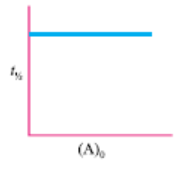What do you understand by the rate law and rate constant of a reaction? Identify the order of a reaction if the units of its rate constant are :
Step-by-Step Solution:
1. Understanding Rate Law:
The rate law of a chemical reaction is an equation that relates the rate of the reaction to the concentration of the reactants. It is generally expressed in the form:
Rate=k(A)m(B)n
where:
- k is the rate constant,
- (A) and (B) are the molar concentrations of the reactants,
- m and n are the orders of the reaction with respect to each reactant.
2. Understanding Rate Constant:
The rate constant k is a proportionality factor that is specific to a particular reaction at a given temperature. It indicates the speed of the reaction and is influenced by factors such as temperature and the presence of catalysts.
3. Identifying the Order of Reaction:
The order of a reaction can be determined from the units of the rate constant k. The units of the rate constant depend on the overall order of the reaction.
- For a zero-order reaction:
Rate=k⟹Units of k=mol L−1s−1
- For a first-order reaction:
Rate=k(A)⟹Units of k=s−1
- For a second-order reaction:
Rate=k(A)2⟹Units of k=L mol−1s−1
- For a third-order reaction:
Rate=k(A)3⟹Units of k=L2mol−2s−1
4. Conclusion:
To identify the order of the reaction based on the units of the rate constant, we can use the following:
- If the units of k are mol L−1s−1, the reaction is zero-order.
- If the units of k are s−1, the reaction is first-order.
- If the units of k are L mol−1s−1, the reaction is second-order.
- If the units of k are L2mol−2s−1, the reaction is third-order.
The rate law of a chemical reaction is an equation that relates the rate of the reaction to the concentration of the reactants. It is generally expressed in the form:
Rate=k(A)m(B)n
where:
- k is the rate constant,
- (A) and (B) are the molar concentrations of the reactants,
- m and n are the orders of the reaction with respect to each reactant.
The rate constant k is a proportionality factor that is specific to a particular reaction at a given temperature. It indicates the speed of the reaction and is influenced by factors such as temperature and the presence of catalysts.
The order of a reaction can be determined from the units of the rate constant k. The units of the rate constant depend on the overall order of the reaction.
Rate=k⟹Units of k=mol L−1s−1
- For a first-order reaction:
Rate=k(A)⟹Units of k=s−1
- For a second-order reaction:
Rate=k(A)2⟹Units of k=L mol−1s−1
- For a third-order reaction:
Rate=k(A)3⟹Units of k=L2mol−2s−1
To identify the order of the reaction based on the units of the rate constant, we can use the following:
- If the units of k are mol L−1s−1, the reaction is zero-order.
- If the units of k are s−1, the reaction is first-order.
- If the units of k are L mol−1s−1, the reaction is second-order.
- If the units of k are L2mol−2s−1, the reaction is third-order.
Topper's Solved these Questions
Similar Questions
Knowledge Check
For a first order reaction, units of rate constant are
Atime−1BL mol−1s−1Cmol L−1s−1Dmol L−1The rate constant of a reaction with nth order will have units:
Alitre1−nmoln−1sec−1Bmol1−nlitre1−nsec−1Cmol1−nlitren−1sec−1DNone of theseFor which order reaction, the unit of rate constant is time−1 ?
AZero orderBFirst orderCSecond orderDThird order
What do you understand by the order of a reaction ? Identify the reaction order from each of the following units of the reaction rate constant :
(i) L−1mols−1
(ii) Lmols−1
View SolutionDetermine the order of reaction and also determine the units of rate constant

View SolutionThe rate constant of a reaction has same units as the rate of reaction. The reaction is of:
View SolutionThe rate constant of zero order reaction has the units
View SolutionThe unit of rate of reaction and rate of rate constant are same for a :
View Solution